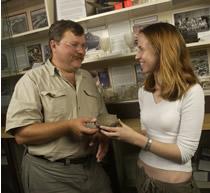
Pottery and Life on the Spanish Colonial Frontier
Hidden on and under Santa Clara University’s campus are examples of California history and prehistory. With help from the Smithsonian Institution, one professor and his student researchers have now analyzed more than 1,500 low-fired earthenware sherds—reading volumes from them about what trade and life must have been like throughout Alta California during the Spanish colonial period.
Pottery did not exist in Northern California until a few centuries ago. Natives instead made baskets that they used for all sorts of things, including cooking. Baskets were light yet durable, perfect for the mobile needs of hunters, gatherers, and fisher folk.
Then the Spanish arrived. “To the Indians living here it was like ‘Star Trek,’” says Russell Skowronek, Santa Clara University associate professor of anthropology, “aliens with animals, plants, and houses that they had never seen, food they had never eaten, technologies they had never encountered.”
Overwhelmed, the Indians did not just end up learning a new religion. “The missions basically functioned as trade schools, teaching them how to become Europeans,” says Skowronek. “One of the trades taught was the making of earthenware.”
| “The Smithsonian– SCU California Pottery Project is unique in its size and scope in the state of California.” |
| —RUSSELL SKOWRONEK ASSOCIATE PROFESSOR OF ANTHROPOLOGY |
Until recently, however, many of Skowronek’s colleagues saw that last point differently. They held that artisans came from Mexico to make pottery at one location in California—Mission San Antonio, near King City. Then it was transported up and down California.
“That just seemed crazy,” Skowronek says. “There were no inland waterways, roads, or other means of moving heavy, fragile goods. Earthenware is not the kind of stuff that you want to move very far, especially when clay is abundant locally.”
The Smithsonian Calls
Five years later, thanks in large part to the efforts of numerous undergraduate researchers and a fortuitous partnership with the Smithsonian, Skowronek’s views have prevailed.
The partnership began in 1998, when Ronald Bishop of the Smithsonian Center for Materials Research and Education (SCMRE) in Maryland first contacted Skowronek. The Center sought to partner with a school where it could have a significant impact and where there were historic ties to the Latino community.
The SCMRE manages a program in Maryland that provides neutron activation analysis for worthwhile scientific projects. The technique involves irradiating small samples of materials in a research nuclear reactor, after which the concentrations of different elements in the
samples can be determined with great accuracy to parts per million. It can be quite useful for archaeologists because identical concentration signatures almost certainly prove the same source material—which is what happened with Skowronek’s pottery sherds.
Within a year of the partnership’s formation, Santa Clara undergraduates were going to Maryland for summer internships. Their initial project—characterizing the composition of mission earthenware samples—finally showed that they had been made at the various mission, pueblo, and presidio sites, and not all at Mission San Antonio. The first Santa Clara student to intern was Sarah Ginn, a combined sciences major and anthropology minor. “Since then, we’ve written and delivered a number of papers, and Sarah’s name has been on practically all of them,” says Skowronek. Sarah is completing her doctorate at U.C. Santa Cruz.
Diverse Backgrounds
A number of other Santa Clara undergraduates have interned at SCMRE, including students from anthropology, history, chemistry, and modern languages. “We’ve even had folks go back there who worked with a botanist on the Center’s staff looking at the preservation of wood and how paint reacts with things through time,” Skowronek says.
Skowronek says he is glad to make use of whatever skills and background that his students have. One project he is working on involves making authentic mission pottery for the first time in 150 years. Helping him is student Kelly Greenwalt, a double major in art and anthropology. “She’s an artist—she knows how to throw pots and I don’t,” says Skowronek. They are using local clay and the same methods used by the missions. “I want to have some complete vessels that are as close to the originals as possible, so I can show people what this stuff actually looked like,” Skowronek explains.
The point of all his labors, Skowronek says, is not proving his theory right and other peoples’ theories wrong. It is to understand—with the making of pottery for example—what it meant to people who had never seen such things before, and how their lives were changed by them.
“You show someone a half-dollar-size piece of pottery and they’re thinking, ‘So what?’ But then I tell them how it represents new technology—and not only in its making but in its use. What was it used for? Cooking. What was being cooked? Foods completely new to the natives here. That’s when everything starts coming together.”